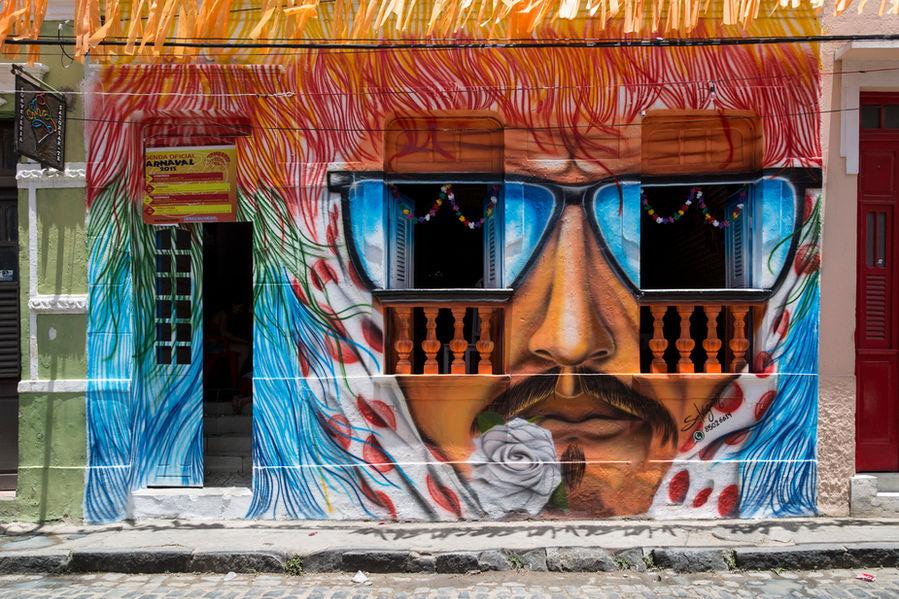
OLINDA´S FREVO
AT CARNIVAL
A MINUTE OR TWO
FEEL THE VIBE
A historic, calm and peaceful city, with about 300 thousand inhabitants. Colorful houses. Street art. Craftsmanship. An impressive concentration of artists. That's Olinda.
Until Carnival arrives.
The day before the party starts, the city is on hold. The streets are populated by a few revelers who anticipated their arrival and a few residents who have not yet left. The houses, the streets, the bars reverberate a last glimpse of tranquility as they wait for the sea of people that will soon invade the city.
Tomorrow, more than 2 million revelers will transform the empty landscape. 2 million people singing, dancing, drinking beer to cool off and to get drunk, kissing and hugging friends and strangers. A sea of euphoria. The perfect environment for the frevo to boil!
After the 5 days of partying, everyone leaves. Olinda becomes Olinda again.
PHOTOS

ORIGIN
The delicious frevo of the Olinda Carnival
Masquerade balls were created in France in the 17th century and quickly became popular in other European countries. During the Renaissance, carnival festivities reached great popularity, especially in Italy (in Rome and Venice). Carnival arrived in Brazil from the festivities that took place in Europe. Pierrot and colombina costumes were soon incorporated into Brazilian carnival.
In 1845, the first masked ball in the Venetian style took place in Recife, in the neighborhood of Madalena. Due to the great success, the dance expanded the following year, when the country carnival was held in the Cajueiro neighborhood. In 1847, the Carnival won the Theaters and was held at the Apolo Theater and the Santa Isabel Theater.
These balls, performed by the elite, to the sound of polkas and mazurkas, were called Mascaradas.
At the same time, in the streets of the city, especially in the port region of Recife, members of the Companhia de Carregadores de Açúcar and the Companhia de Carregadores de Mercadorias (mostly black) gathered to celebrate in the streets, to the sound of marches and improvised music, playing and setting off fireworks.
As the Mascaradas (of the elite) left the salons and took to the streets, they began to confront the games of the popular classes and, from 1862 onwards, the process of organizing street groups began.
Then, the first frevo clubs in Recife appear; the Clube dos Symphaticos, the Mimo de Amor and the Sociedade Musical Arte e União, founded in 1886 and, in 1888, the Clube das Pás, founded by a group of coal workers and stevedores working on the city's harbor pier (probably the most old still in operation).
Unlike the allegory and criticism clubs (founded by merchants, employers, and other members of the Recife elite), the pedestrian clubs developed their own way of celebrating the days off. In place of cars and luxurious floats, the people went out on foot and developed their own chants and maneuvers. They also replaced the ballroom music with the vibrant marches of bands from the military and police corporations (responsible for the animation of civic parties and processions at that time).
The repertoires of the military and police corporations included several genres, such as marches, folded songs, hymns, maxixes, quadrilles and polkas, in addition to the erudite repertoire. And it was precisely from this great mixture of genres that the frenetic, exciting, fast and vigorous sound of frevo gradually emerged.
In frevo, there is no way to separate dance and music. It is not known whether the dance adapted to the music, whether the music sped up as a function of the movements, or whether both things occurred simultaneously.
The word frevo appears as a corruption of the verb to boil (“frever”), this is because frevo is a frenetic dance, with a very fast pace.
One of its most striking features is the use of colored umbrellas, an object that plays an important role in dance. Its origin is probably linked to the work elements of the first carnival clubs that took to the streets: brushes, sticks and brushes for the Caiadores, brooms for the Vassourinhas, axes for the Lumberjacks, etc.
As hand props are instruments that easily turned into weapons, they were soon suppressed. Still, researchers speculate that the origin of the umbrella is related to this situation. And that it could still be seen as a weapon, as it was a piercing instrument that served both defense and attack. Umbrellas, therefore, would have replaced the original work instruments and started to characterize the frevo dancer.
LET´S DANCE
Frevo class with
Nelson Araujo and Camila Penteado









